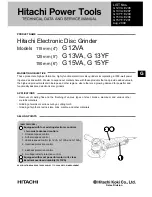
-9-
4. Operation Phenomena to Note in Sales Promotion
(1) Constant speed control
The rotation speed during operation may fluctuate somewhat depending on the conditions of use and
power source.
(2) Soft-start speed control
Immediately after startup, the rotation speed may fluctuate somewhat depending on the conditions of
use and power source.
(3) Variable speed control (G 12VA, G 13VA and G 15VA)
For adjusting the number of revolutions, the models above (G 12VA, G 13VA and G 15VA) are
equipped with an electronic infinite-variable-speed drive by which the number of revolutions can be
changed according to specific use. For example, turning and setting the dial scale to 6 increases the
number of revolutions; turning and setting it to 1 decreases the number of revolutions. Before using the
tool, use the dial to set the number of revolutions. Refer to the following table as a rough guide. Be
careful not to turn the dial scale to any setting value below 1 or above 6.
Immediately after shifting gear in the tool, the rotation speed may fluctuate somewhat depending on the
conditions of use and power source.
Dial
Use
Tools
1
Polishing, finishing
2
3
4
Removal of paint or other coating
Removal of rust
Removal of burrs
Radial grinding disc
Sanding disc
5
Grinding
Depressed center wheel
6
Rough grinding
Cutting
Depressed center wheel
Diamond wheel
(4) Overload protection control
(a) Overload protection control tends to be easily actuated by certain types of work. Applying excessive
pressure on the tool during cutting or similar heavy-duty operation will actuate overload protection
control and automatically stop the motor. This is because overload protection control detects the
increased flow of current caused by excessive pressure on the tool, and automatically turns off the
motor to protect it against possible overload burnout. The customer should be advised that the
Models G 12VA, G 13VA, G 13YF, G 15VA and G 15YF are specifically designed to perform more
efficiently and faster with considerably less pressure applied than that required for conventional disc
grinders, and that skillful use of the tools with minimal applied pressure will avoid actuating overload
protection control. The customer should also be advised, however, that the overload protection
control feature cannot always prevent overload motor burnout under all possible use conditions.
(b) Instruct the customer to immediately turn off the main switch in case overload protection control is
actuated, separate the tool attached to the grinder from the workpiece, turn on the main switch, wait
until the rotation speed increases to normal speed, and then resume work. Also advise the customer
that overload protection control will quickly reactuate even under a slight load if the customer
resumes work before the rotation speed increases to the normal level.
(c) When beginning operation, note that you may inadvertently turn on the switch immediately after
pressing the depressed center wheel or cut-off wheel against the workpiece before the tool reaches
full rotation speed. (This will actuate overload protection control. Therefore, strongly recommend that
the customer never turn the switch on with the depressed center wheel in contact with the workpiece
or press the wheel against the workpiece when beginning operation until normal rotation speed has
been attained.)













































